Don't wanna be here? Send us removal request.
Text
Natural Beauty
Artists Statement
Final Project
Isolation and taking classes from home due to COVID-19 has provides/forced me to come up with a new idea for my final project. Living in the adirondacks I am well aware of their beauty but to take pictures of the mountains and lakes has been done time and time again. We also had recently learned about glitching or databending which fascninated me. I decided to combine the two and create glitched images of the scenery that is so traditionally beautiful. By doing this I emphasize different aspects of the pictures and scenery that may not be given much attention originally. The process was done with photoshop and audacity.
2 notes
·
View notes
Photo

Carl Heillman II Photo of the Great Smoky Mountains
1 note
·
View note
Photo

I went to the Louvre! Well, I went to the virtual tour online... This is an image from the “Salle Basse”. While I still would love to visit the Louvre in real life, this works as an interim option. With the increase of technological capabilities, art is moving online for better or worse. As a digital artist I am excited, as a physical artist, I am fearful. While some work can be seen on a screen, there are just some things that cannot be fathomed outside of experiencing it firsthand. I feel it is similar to reading online and holding a book. There are positives to both but for different things, art is the same. Some are is made to be on a screen, some are not. I do not think we should have to choose one or another. Yes, environmentally, digital may be a good move, but that’s not to say that we can’t use recycled materials and reduce our waste. We can enjoy both online and real life exhibits which is amazing, providing access to art that we may not have gotten to see otherwise, but still being able to go to a closer exhibit and have the experience of seeing art in person.
0 notes
Text
The Museums’s Old/The Library’s New Subject Response
Douglass Crimp
From The Contest of Meaning: Critical Histories of Photography, Richard Bolton, ed. (Cambridge, Mass.: MIT Press, 1989) pp. 8-14
From the title of the excerpt I had not expected the in depth description of the autonomy of photography and the path to postmodernism. At first, the story of Julia van Haaften and her project to collect and display photography from the New York Public Library made sense to me. She gathered images that may not have had the chance to be viewed as art and gave them that chance. Where I began to get lost was when the photographs were beginning to be reclassified and how that related to postmodernism. It was difficult to tell whether the author was in favor of this or not. Multiple times it seems as though contradictory statements are made about the autonomy of photography and what modernism and postmodernism are.
One part that particularly stood out to me was on the third page when the author begins to speak about how photography, once labeled a medium of art, can no longer serve the purpose of anything other than aesthetic purposes. My initial reaction is to object and still I am not in complete agreement. I can see the reasons behind his argument but there are questions I have about this that cannot be answered though this excerpt. I do not see how once something is labeled as aesthetic, it cannot be anything else.
Lastly was the part about Ed Ruscha’s Twentysix Gasoline Stations. The author first thinks the book should be with other art books, then changes his mind to agree with its placement with other historical books. What I fail to see is why it must exist in only one category. Physically, yes, you can only put it in one place, but besides that, why can it not be historical and artistic. I do not have a great understanding of postmodernism and so I fear that I may be deeply misinterpreting the article, but my initial reactions to the division of art and history or other non-aesthetic purposes is to disagree.
0 notes
Photo

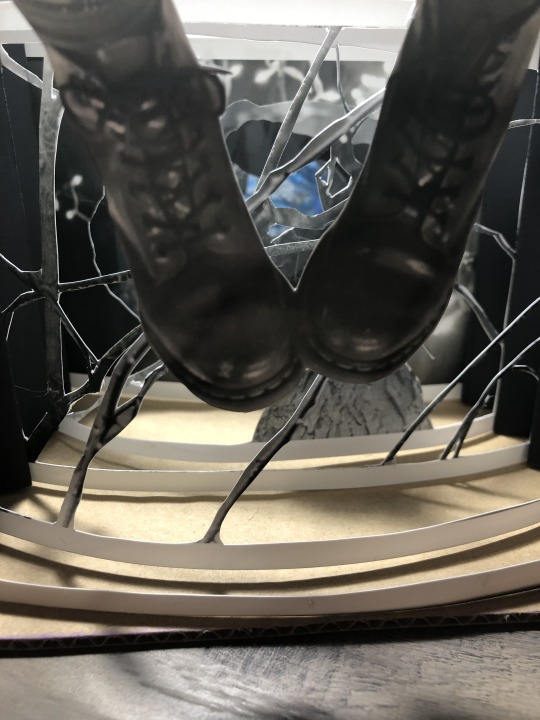




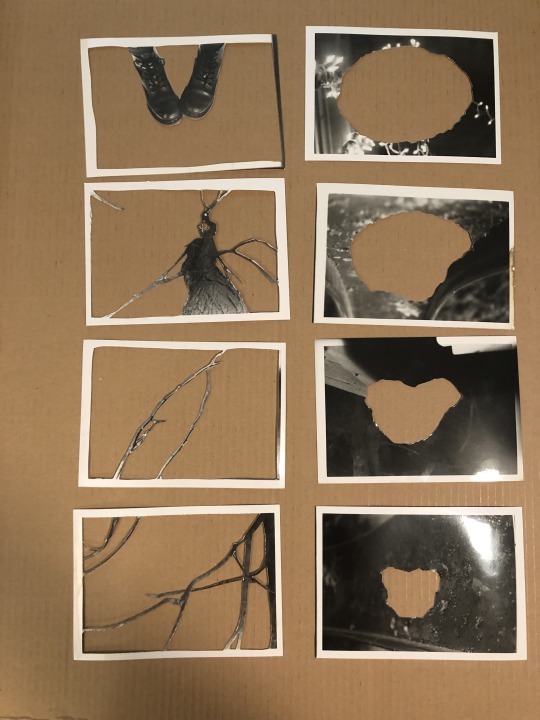

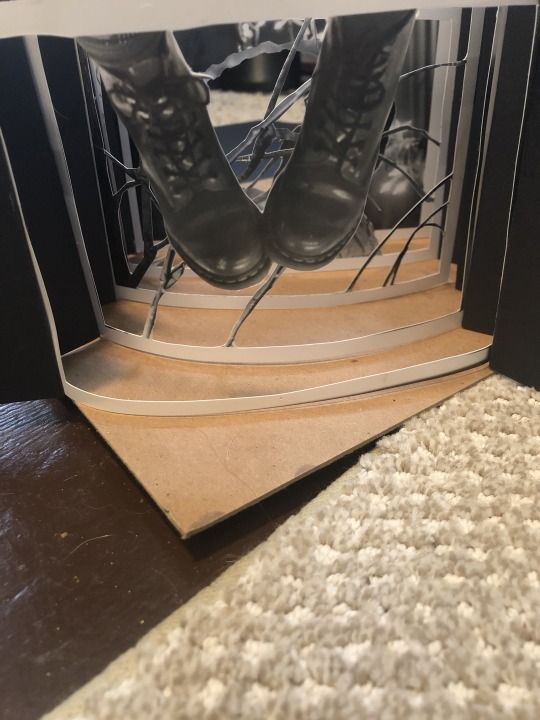
The process of my Tunnel book project titled “Down the Rabbit Hole”
0 notes
Text
Project 2 “Down the Rabbit Hole”
I certainly did not expect to take the path that I did to get here. With the virus and remote learning throwing a wrench into my original project, I was forced to create something new with the resources I have. It is the first time I went back to look at the photos I created in high school. Back then, I thought they were interesting and “cool”, I thought myself quite the photographer. Looking at them now I see the many, many mistakes and just the overall lack of quality in the images. But that does not make them worthless, or less meaningful. So I took these already existing images and pushed them further, beyond the constraints of a 2-D image into a 3-D object. I created a tunnel book by cutting and reforming the images to make a sequence and provide meaning to the images as they work with one another, as they are not so successful by themselves. The sequencing is meant to convey a sense of peering down into a hole, like the rabbit hole in Alice in Wonderland, a story I so often come back to in my art. From the feet dangling over the edge, to the tangles of roots and down the dark hole to a soft blue image. The “bottom” of the hole can be taken very literally as water, or a representation of tears like in Lewis Carroll's story, or as something of a more abstract nature. In the end I am happy with the work I created even though it was not the original idea I had started out with. Funny how those works of art are more successful for me.
0 notes
Text

While not technically a photo, this is a screenshot of a short video of some camels from the Syracuse zoo walking through other exhibits, an activity that could not be done without this social distancing and staying at home. This was a reminder that even the worst situations can give chances for other situations that might not have happened otherwise.
0 notes
Text
Compression Aesthetics: Glitch from the Avant-Garde to Kanye West
From InVisible Culture
http://ivc.lib.rochester.edu/compression-aesthetics-glitch-from-the-avant-garde-to-kanye-west/
As someone who isn’t technologically “proficient” and often deals with making mistakes in photoshop and analog photography the idea of glitches and mistakes in art intrigues me. To be able to use mistakes purposefully and creatively, to me, is one of the aspects that make an artist a true artist.
Glitch as a social statement is not something I really considered before reading this. The commentary on “clean” and desirable works relates, I think, to social media and how pictures are really edited and “perfect”, far from glitches and mistakes.
I think there is a real natural beauty to glitches and mistakes because they are natural. They happen as a result of life, humans make mistakes and the idea that mistakes are not beautiful, in art, because they are not intended is not one I agree with.
1 note
·
View note
Text
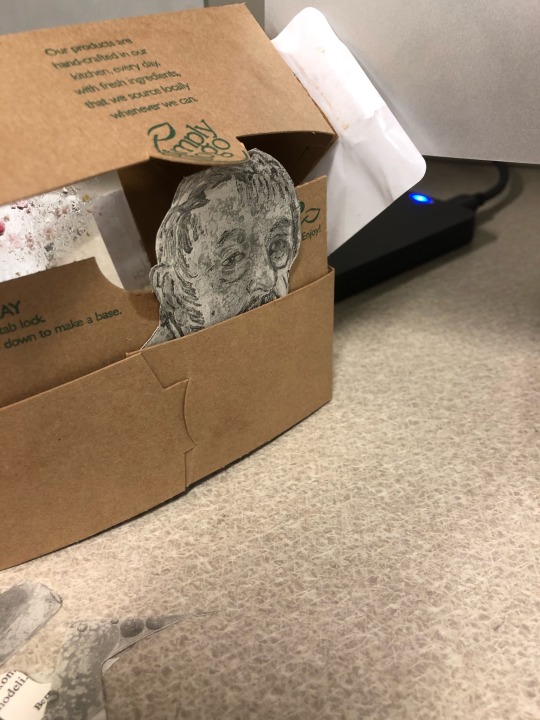
Photo of the week is one I took while working on the altered objects exercise. I took a cutout and put it in my sandwich box and found it entertaining.
1 note
·
View note
Text
something worth searching for
Reaction to Sarita Zaleha’s exhibition at the Davis Gallery
The theme of this year’s gallery at HWS is very present in Sarita’s work. Her combination of her original work and the documents and objects from the historical society is very interesting and I believe it is executed very well. She brings to light an important part of Geneva history I had no clue about in an engaging and beautiful way.
Her exploration of different mediums, installation, historical objects, printing press, cyanotypes and video and photography, work well. I particularly enjoyed her cyanotypes which she printed on her own handmade paper, something I wish I had the resources to do. Her cyanotypes are not her own image, but that of a symbols of the Geneva mineral water well from historical documents and then used as a piece of art in her exhibition. She takes something that wasn’t hers originally, but changes it enough that her own will is included as well as her creativity.
0 notes
Text
Gesture, Reception of Photograpy
Vilem Flusser, Towards a Philosophy of Photography
My initial response is that it feels a little contrived. I think I get the main message of gesture and culture in the first reading, but I had to read the same paragraph multiple times to really understand. I feel that he could get the same point across in less words. Especially the paragraph with “ neither Newtonian or Einsteinien, but they divide time and space into rather clearly separated areas” later in the paragraph I feel that he does a better job explaining it more effectively.
The second reading the reception of photographs intrigued me. The phrase “ consumed by the greed of their camera” is very thought provoking. The idea that people are only seeing the world through a photographic lens is interesting as well as the idea of being literate or illiterate in photography. I don’t agree with how he poses all of his information, the certain references to cultures and people don’t always feel used in the best way (a little cringey at times like the “magic” and native americans)
All in all, I can appreciate his philosophy and some of his points about the culture and reception of photography make sense, but I can’t get over some of the choices of words and references which cloud my overall view of the readings.
0 notes
Photo
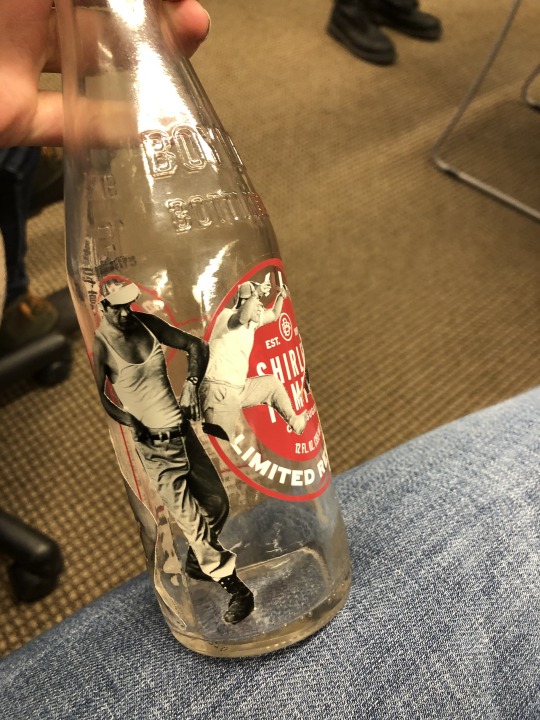
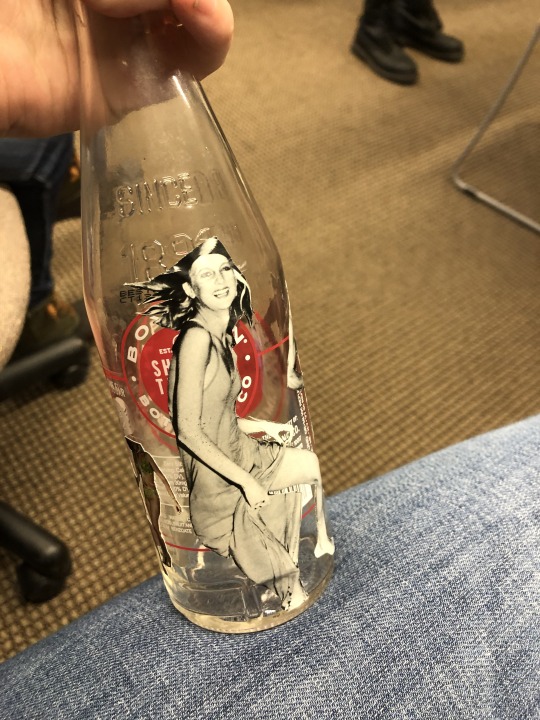
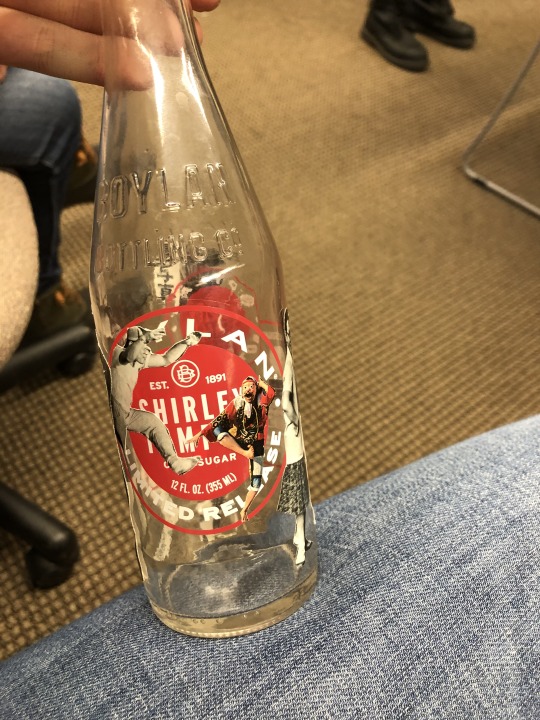
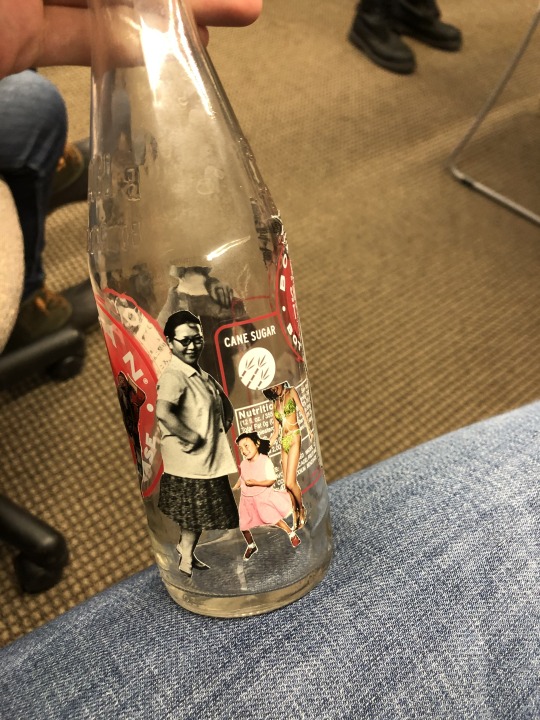
Altered Materials project. The bottle was originally a Shirley Temple soda, named after the child star/dancer herself. So I found images of people dancing, being joyful and placed them over top the soda to create an altered object. It also plays a little with the idea of sugar and the “high, dance-like energy” it gives you. I originally thought about making something with the intention of being “political” or “topical” but I ended up moving to a more positive, less heavy topic (though I suppose you could always make it topical or political). My intention became to bring attention to dancing and the emotion people feel when dancing. While Joe Orton’s work was more provocative and risque, my project is less so, but I hope it still gets the message across.
0 notes
Text
Project 1 Artist Statement
This project proved to be conceptually challenging to me. At first I had no idea what to do with the photo I had chosen. It didn’t really “speak” to me. So I decided to take the mindset of “if this were a picture I took, what would I do with it”. I decided to take photos of landscapes and edit them in photoshop in a way that imitated parts of the original image and then using the digital negative technique, developed photos in the dark room.
We also explored the idea of collage which is an element I also wanted to include in this project, so I sat for a while and thought about how to piece all the images together. I took some risks and asked myself what does this piece need and if I add this collage, does it take away or contribute to the piece as a whole. I am still unsure of it, but hope that after the critique I can be more confident in the decisions I made and the potential ones I need to do.
0 notes
Photo

Photo of the week featuring me, in my bathroom. This photo was used a reference for an intaglio print using open bite.
0 notes
Text
Reading Photography
Clark Graham, The Photograph. Chapter 2 How Do We Read a Photograph?
I vaguely recall reading a part of this for the Intro to imaging class, or referencing it at the very least. I picked up on a few points during the reading, particularly the points on mirroring and the two different ways you can read a photograph, denotative and connotative.
I feel that Graham has a back and forth about photography and mirroring life in the beginning of the chapter, and I didn’t really agree with either of his points and instead agree wholly with a phrase he mentions later in the chapter. “Thus we can read a photograph within its own terms of reference, seeing not so much as the reflection of a ‘real’ world as an interpretation of that world” (p.33) I feel that this one definition of photography that I really agree with. Photography is one of the closest things to being able to see things through someone else’s perspective, and even then it’s not exact.
As for the denotative and connotative readings of a photograph, I feel that Graham leans too far into connotative readings. I think the reading depends on the intent behind taking a picture. Of course, in the end, it really is up to the viewer to decide, but some photographers take photos with the intent of showing the world as it is (to them) while others take photos to represent complex and intricate ideas that are not “written clearly” in the image.
0 notes
Photo
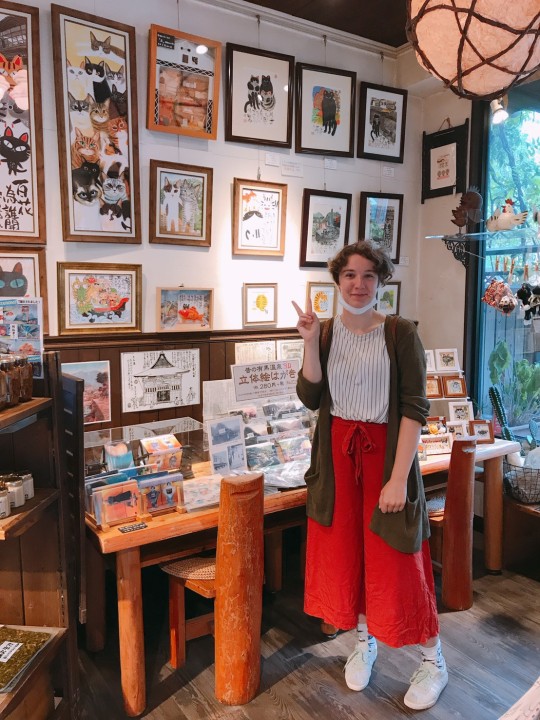
Photo of the week. I’ve really been missing Japan lately and wanted to post a picture of me there. This is in a shop in Arima near Kobe, Japan. Taken by my host father.
0 notes

